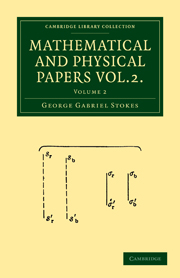Book contents
- Frontmatter
- Contents
- Notes on Hydrodynamics. III. On the Dynamical Equations
- On the constitution of the Luminiferous Ether
- On the Theory of certain Bands seen in the Spectrum
- Notes on Hydrodynamics. IV. Demonstration of a Fundamental Theorem
- On a difficulty in the Theory of Sound
- On the Formation of the Central Spot of Newton's Rings beyond the Critical Angle
- On some points in the Received Theory of Sound
- On the perfect Blackness of the Central Spot in Newton's Rings, and on the Verification of Fresnel's Formula for the intensities of Reflected and Reflacted Rays
- On Attractions, and on Clairaut's Theorem
- On the Variation of Gravity at the Surface of the Earth
- On a Mode of Measuring the Astigmatism of a Defective Eye
- On the Determination of the Wave Length corresponding with any Point of the Spectrum
- Discussion of a Differential Equation relating to the Breaking of Railway Bridges
- Notes on Hydrodynamics, VI. On Waves
- On the Dynamical Theory of Diffraction
- On the Numerical Calculation of a class of Definite Integrals and Infinite Series
- On the Mode of Disappearance of Newton's Rings in passing the Angle of Total Internal Reflection
- On Metallic Reflection
- On a Fictitious Displacement of Fringes of Interference
- On Haidinger's Brushes
- Index
On the perfect Blackness of the Central Spot in Newton's Rings, and on the Verification of Fresnel's Formula for the intensities of Reflected and Reflacted Rays
Published online by Cambridge University Press: 07 September 2010
- Frontmatter
- Contents
- Notes on Hydrodynamics. III. On the Dynamical Equations
- On the constitution of the Luminiferous Ether
- On the Theory of certain Bands seen in the Spectrum
- Notes on Hydrodynamics. IV. Demonstration of a Fundamental Theorem
- On a difficulty in the Theory of Sound
- On the Formation of the Central Spot of Newton's Rings beyond the Critical Angle
- On some points in the Received Theory of Sound
- On the perfect Blackness of the Central Spot in Newton's Rings, and on the Verification of Fresnel's Formula for the intensities of Reflected and Reflacted Rays
- On Attractions, and on Clairaut's Theorem
- On the Variation of Gravity at the Surface of the Earth
- On a Mode of Measuring the Astigmatism of a Defective Eye
- On the Determination of the Wave Length corresponding with any Point of the Spectrum
- Discussion of a Differential Equation relating to the Breaking of Railway Bridges
- Notes on Hydrodynamics, VI. On Waves
- On the Dynamical Theory of Diffraction
- On the Numerical Calculation of a class of Definite Integrals and Infinite Series
- On the Mode of Disappearance of Newton's Rings in passing the Angle of Total Internal Reflection
- On Metallic Reflection
- On a Fictitious Displacement of Fringes of Interference
- On Haidinger's Brushes
- Index
Summary
When Newton's rings are formed between two glasses of the same kind, the central spot in the reflected rings is observed to be perfectly black. This result is completely at variance with the theory of emissions, according to which the central spot ought to be half as bright as the brightest part of the bright rings, supposing the incident light homogeneous. On the theory of undulations, the intensity of the light reflected at the middle point depends entirely on the proportions in which light is reflected and refracted at the two surfaces of the plate of air, or other interposed medium, whatever it may be. The perfect blackness of the central spot was first explained by Poisson, in the case of a perpendicular incidence, who shewed that when the infinite series of reflections and refractions is taken into account, the expression for the intensity at the centre vanishes, the formula for the intensity of light reflected at a perpendicular incidence first given by Dr Young being assumed. Fresnel extended this conclusion to all incidences by means of a law discovered experimentally by M. Arago, that light is reflected in the same proportions at the first and second surfaces of a transparent plate I have thought of a very simple mode of obtaining M. Arago's law from theory, and at the same time establishing theoretically the loss of half an undulation in internal, or else in external reflection.
- Type
- Chapter
- Information
- Mathematical and Physical Papers , pp. 89 - 103Publisher: Cambridge University PressPrint publication year: 2009First published in: 1883
- 2
- Cited by



